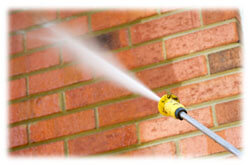Brick Cleaning: A Proven Profitable Business for Both Contractors and Distributors
 By Victor Hayes Popovics
By Victor Hayes Popovics
Power Equipment Expert
Ultimate Washer Inc.
Last Updated: 2012-11-09
Brick is a popular choice for exterior walls, sidewalks, and patios for a good reason: well laid brick is a classic look. The problem is that the brick and mortar that looks so nice can become stained, discolored,dirty, and grimy over time and lose this classic look. A good sealant will help, but your brick will eventually need to be cleaned. Read the following guide to learn about brick cleaning:
The first step is the preparation stage. Most brick will have some stray mortar, concrete, or other hard sediment, so you may need to get out a hand scraper and put in some hard work. The danger of scraping brick is that some less dense, painted, or textured brick can be easy to damage. It is important to take special care and communicate with your customer when scraping brick. This is also a good time to fill in any cracks or joint separations of your mortar joints to prevent water from getting in. This step is especially important when cleaning brick walls.
It is important to not use too tight of a spray pattern for you brick cleaning as this can damage the brick. According to an article I read that was published by a popular brick manufacturer, Ibstock, anything smaller than a 25° nozzle is not recommended.1 It is also important to remember to use a lower pressure-too much pressure can damage the mortar and brick easily. For light colored, painted, or textured brick, you will not want to use any more than 1000 PSI as you can change the appearance of the brick with high pressure. If you have a hot water power washer, this alone may be sufficient for your brick cleaning cleaner will have a rotating arm with 2-4 nozzles attached to the ends of the arm. The flow rate (GPM) of the pressure washer will be divided between the nozzles on the surface cleaner, but the pressure will remain constant.
With that in needs, but if you are using cold water, you may have to get

some chemicals involved. A good pressure washer detergent can be applied to wet brick to aid in the cleaning process. When using a detergent, you will want to let it stay in place for 5-10 minutes before rinsing it off. If your brick has any mold or algae stains, you might have to use a mold remover as well. It should be noted that hot water can be damaging to glass, gutters, some wood, paint, and putty. Use caution and protect these surfaces when cleaning with hot water.1
If you notice any tough stains while brick cleaning, you can use a brush to scrub it and make it look new again. Using a brush can take a while, though, because you will need to keep spraying the brick with water and detergent and then brushing it. Pressure washer brushes can save you time, however, by combining all of these things. These pressure washer brushes attach directly the wand on your washer for maximum speed and efficiency. If you plan on using a brush that is not a pressure washer attachment, you should be careful to not use a brush with steel bristles. As Ambrico points out, this can leave behind steel particles which can rust and discolor your brick.2 Another piece of equipment that can be helpful for brick cleaning is a surface cleaner. Pressure washer surface cleaners are an attachment for your machine that will allow you to clean a larger area at one time. Surface cleaners come in varieties of 8 inches all the way up to 36 inches. A surface mind, it is important to pick a surface cleaner with an operating pressure of no more than 1000 PSI. You will be able to use some of the smaller models such as the 8-12 inch surface cleaners for brick cleaning.
Read Related Articles:
- Deck Cleaning
Tips on how to prepare and clean your Wooden Deck.
- Power Washing: a great way to give your home a quick facelift
Pressure washing the exterior of your house is worth your time and money.


